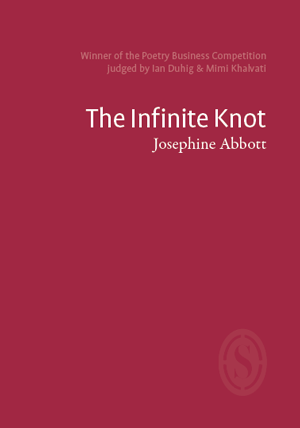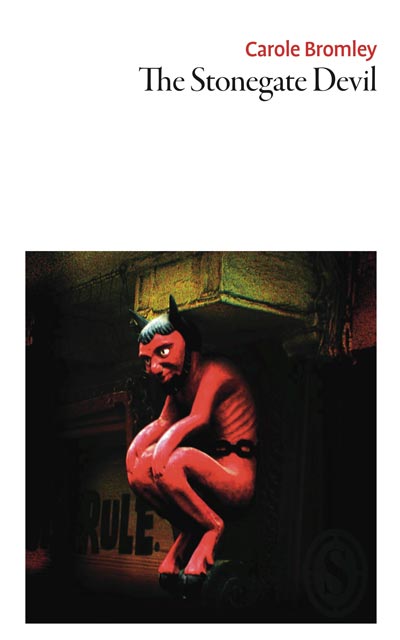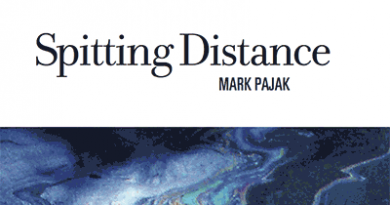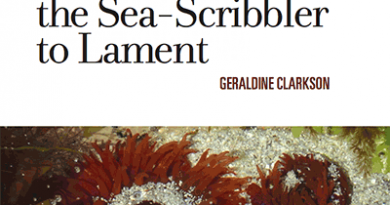The Infinite Knot by Josephine Abbott
– Reviewed by John Mee –
In The Infinite Knot, Josephine Abbott writes compellingly about loss and incomprehension, nature and science, marriage and companionship. Her first collection, Trying Not to Levitate, was published by Blinking Eye in 2006, and The Infinite Knot was a winner of the Poetry Business International Book and Pamphlet Competition 2016/17, judged by Ian Duhig and Mimi Khalvati.
The pamphlet’s title suggests the Shrivatsa, the eternal or endless knot, which is one of Buddhism’s Eight Auspicious Symbols. The idea of infinity, or at least circularity, is reflected in the pamphlet’s structure: it consists of 21 poems numbered from (i) to (xi) and back to (i) again. The poems are also titled, but only in the Contents at the start. I found myself flipping back from each poem to the Contents, only to discover that the titles were comparatively bland and descriptive. On the other hand, presenting the poems with bracketed roman numerals instead of titles helps to suggest a ‘stripped-to-the-core quietness’ (‘Zero Decibels’). This resonates with the poet’s restrained verbal palette, and with the formal unity of the pamphlet, which consists largely – though not exclusively – of sonnet-like poems (14 lines or, less frequently, 12 or 16 lines long), often written in couplets.
The opening poem, ‘Consolation’, compares the rain of distant worlds – ‘drops of iron / from metal clouds’ and ‘molten glass / blown sideways by 4,000 mph winds’ – with the earthly rain ‘that prickles my skin awake/ and puts my heart to sleep’. It concludes:
It’s only a bit of rain. I won’t melt.
It’s not that cruel to bury someone in it.
Abbott returns to this territory in the final poem (‘The Rain Ghosts’), also numbered ‘(i)’, which begins ‘Rain ghosts are pattering on the glass; / what they want is to be let in.’ They ‘have something they’re dying to tell you / and only one syllable they can use to whisper it.’ Sometimes there are links, in terms of general theme or a shared image, between the poems that are paired by the pamphlet’s circular numbering scheme, though I wasn’t able to see the connection in every case.
Loss is also central to poems like ‘Sister’ and ‘Borrowed Scenery’:
I’ll have to give the mountains back,
and that blueness there, in the distance,that trail of mist, will be all that’s left.
Loss brings with it a desire to comprehend: ‘And there’s something sad / in the way I still can’t understand’ (‘Falling Foss, North Yorkshire’). In ‘Celtic Tree Alphabet’, the author wants to learn ‘the beth-luis-nion’:
I’ll practice every day
some words in holly, hazel and willow,
some phrases of oak, ivy, birch, ash,until the stark lines of the language
at last make some kind of sense.
The poems demonstrate a particular interest in science, one way in which to try to understand the natural world. The author is ‘a set of chemicals / in my own alembic, cucurbit, retort, / being heated and distilled … // But what will be extracted / is anyone’s guess’ (‘A Sure Chemistry’). Other poems meditate on ‘White Noise’, ‘Alchemy’ (in the nano-dimension), and the nature of fire (‘A Chemical Formula for Fire’):
Not-quite-gas, not-liquid, not-solid,
fire breathes air; stirs itself into it
like red ink into water. It feeds onand needs the material it destroys;
Another theme in the pamphlet is the idea that, in the face of ageing and the prospect of death, some comfort can be found in the arms of a partner (‘Nocturne’):
There’s no such thing as drowning in the dark
when we can hang on to shreds of lightthe way we cling to each other.
…
We’re not afraid. Not of the dark.
The longest poem in the pamphlet, ‘The Philemon and Baucis Syndrome’, revisits the myth of the old married couple who were generous when visited by Zeus and Hermes in disguise, and were transformed on their deaths into a pair of intertwining trees.
When the time comes, we’ll be ready.
By then, I’ll have noticed the rougheningof my skin, and how my limbs are stiffening.
You’ll be starting to come into leaf,losing your eyesight, growing deaf.
…
[We’ll] touch more closely than skin to skin. Oh,
when the time comes, we’ll be more than ready.
Despite this comparatively downbeat beginning, the poem ends on a note of celebration, on the image of the ‘Marriage-tree: double-bedded; / deep-rooted; far-eyed.’
The pamphlet never strays far from a close observation of the natural world. There is, for example, the image of two swans that are ‘symmetrical as bedside lamps’ (‘Two Swans on the Derwent, Derbyshire’) or ‘a full moon just within reach: / an irresistible, halved white peach’ (‘Borrowed Scenery’), the poet’s tendency to compare natural phenomena to domestic objects being reminiscent of Elizabeth Bishop. The separation of pamphlet’s second-to-last poem, ‘Bees’, from its title (back on the Contents page) lends it the quality of a riddle:
little servants of the gods: dead souls.
There’s something primitive about them:the way they’re singing to themselves,
and me, their Old English name: ymbe.
Physically, the pamphlet is compact and attractively presented. I had not encountered Abbott’s poetry before, and was impressed. These poems are elegant, keenly observed, and affecting. I hope that, before too long, we will see a second full collection from this talented poet.





